Avian infectious bronchitis virus disrupts the melanoma differentiation associated gene 5 (MDA5) signaling pathway by cleavage of the adaptor protein MAVS
- PMID: 29132350
- PMCID: PMC5683607
- DOI: 10.1186/s12917-017-1253-7
Avian infectious bronchitis virus disrupts the melanoma differentiation associated gene 5 (MDA5) signaling pathway by cleavage of the adaptor protein MAVS
Abstract
Background: Melanoma differentiation associated gene 5 (MDA5) and retinoic acid-inducible gene-I (RIG-I) selectively sense cytoplasmic viral RNA to induce an antiviral immune response. Infectious bronchitis virus (IBV) is one of the most important infectious agents in chickens, and in chicken cells, it can be recognized by MDA5 to activate interferon production. RIG-I is considered to be absent in chickens. However, the absence of RIG-I in chickens raises the question of whether this protein influences the antiviral immune response against IBV infection.
Results: Here, we showed that chicken cells transfected with domestic goose RIG-I (dgRIG-I) exhibited increased IFN-β activity after IBV infection. We also found that IBV can cleave MAVS, an adaptor protein downstream of RIG-I and MDA5 that acts as a platform for antiviral innate immunity at an early stage of infection.
Conclusions: Although chicken MDA5 (chMDA5) is functionally active during IBV infection, the absence of RIG-I may increase the susceptibility of chickens to IBV infection, and IBV may disrupt the activation of the host antiviral response through the cleavage of MAVS.
Keywords: Infectious bronchitis virus; Mavs; Melanoma differentiation associated gene 5; Retinoic acid-inducible gene-I.
Conflict of interest statement
Ethics approval and consent to participate
The Jiangsu Administrative Committee for Laboratory Animals approved all animal studies (Permit number: SYXKSU-2007-0005) according to the guidelines of Jiangsu Laboratory Animal Welfare and Ethical of Jiangsu Administrative Committee of Laboratory Animals.
Consent for publication
Not applicable
Competing interests
All authors declare that they have no competing interests.
Publisher’s Note
Springer Nature remains neutral with regard to jurisdictional claims in published maps and institutional affiliations.
Figures
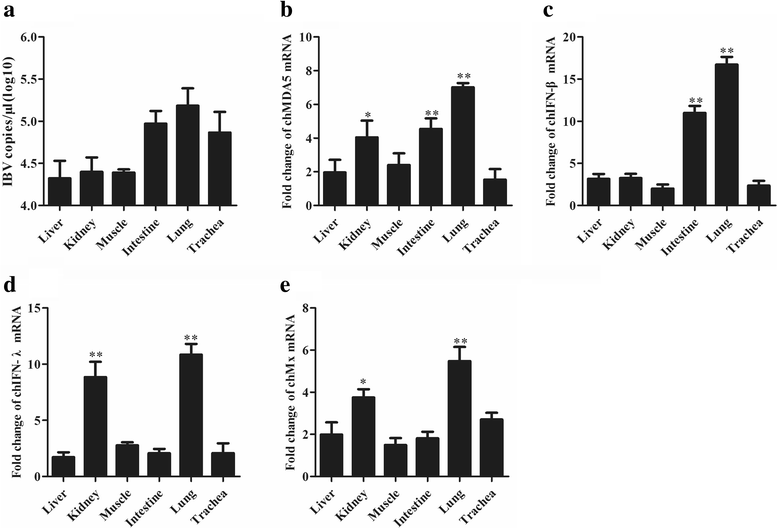
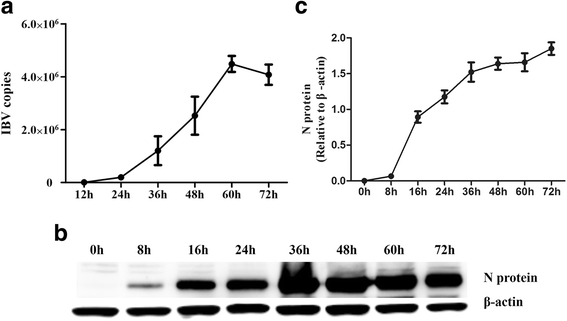
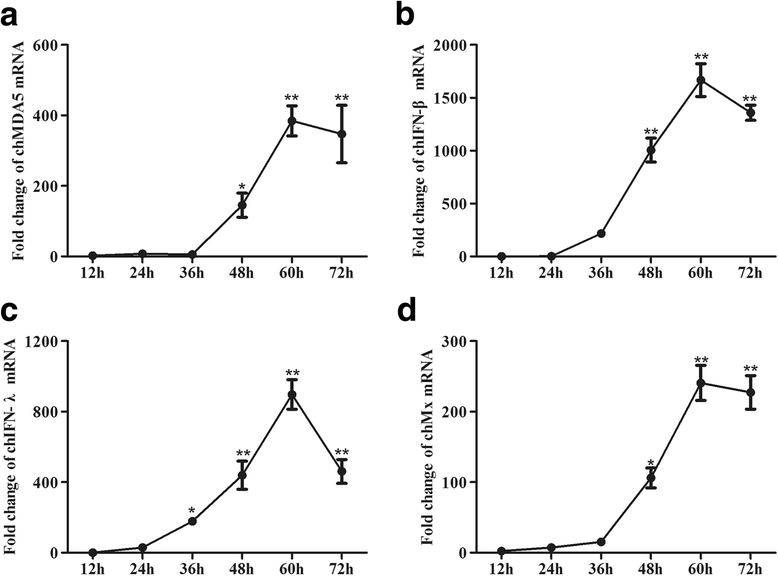
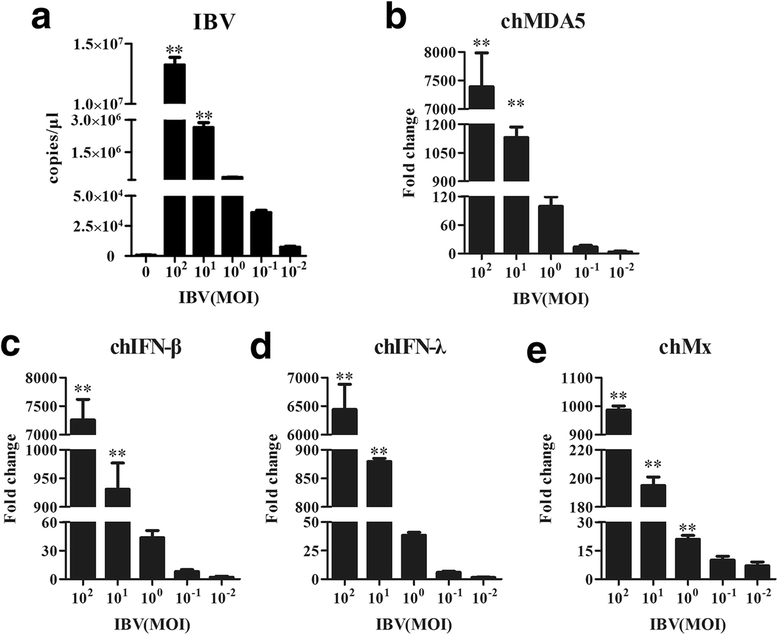

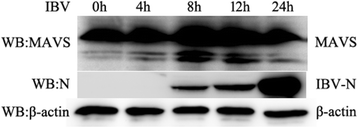

Similar articles
-
Responses of the Toll-like receptor and melanoma differentiation-associated protein 5 signaling pathways to avian infectious bronchitis virus infection in chicks.Virol Sin. 2016 Feb;31(1):57-68. doi: 10.1007/s12250-015-3696-y. Epub 2016 Feb 19. Virol Sin. 2016. PMID: 26920710 Free PMC article.
-
Porcine Deltacoronavirus Accessory Protein NS6 Antagonizes Interferon Beta Production by Interfering with the Binding of RIG-I/MDA5 to Double-Stranded RNA.J Virol. 2018 Jul 17;92(15):e00712-18. doi: 10.1128/JVI.00712-18. Print 2018 Aug 1. J Virol. 2018. PMID: 29769346 Free PMC article.
-
RIG-I/MDA5/MAVS are required to signal a protective IFN response in rotavirus-infected intestinal epithelium.J Immunol. 2011 Feb 1;186(3):1618-26. doi: 10.4049/jimmunol.1002862. Epub 2010 Dec 27. J Immunol. 2011. PMID: 21187438
-
Negative regulators of the RIG-I-like receptor signaling pathway.Eur J Immunol. 2017 Apr;47(4):615-628. doi: 10.1002/eji.201646484. Eur J Immunol. 2017. PMID: 28295214 Free PMC article. Review.
-
Host Antiviral Responses against Avian Infectious Bronchitis Virus (IBV): Focus on Innate Immunity.Viruses. 2021 Aug 26;13(9):1698. doi: 10.3390/v13091698. Viruses. 2021. PMID: 34578280 Free PMC article. Review.
Cited by
-
The long non-coding RNA lncRNA-DRNR enhances infectious bronchitis virus replication by targeting chicken JMJD6 and modulating interferon-stimulated genes expression via the JAK-STAT signalling pathway.Vet Res. 2024 Nov 5;55(1):141. doi: 10.1186/s13567-024-01396-6. Vet Res. 2024. PMID: 39501382 Free PMC article.
-
Dietary Peppermint Extract Inhibits Chronic Heat Stress-Induced Activation of Innate Immunity and Inflammatory Response in the Spleen of Broiler Chickens.Animals (Basel). 2024 Apr 11;14(8):1157. doi: 10.3390/ani14081157. Animals (Basel). 2024. PMID: 38672305 Free PMC article.
-
QX-type infectious bronchitis virus infection in roosters can seriously injure the reproductive system and cause sex hormone secretion disorder.Virulence. 2023 Dec;14(1):2185380. doi: 10.1080/21505594.2023.2185380. Virulence. 2023. PMID: 36883685 Free PMC article.
-
Protective effects of hypericin against infectious bronchitis virus induced apoptosis and reactive oxygen species in chicken embryo kidney cells.Poult Sci. 2019 Dec 1;98(12):6367-6377. doi: 10.3382/ps/pez465. Poult Sci. 2019. PMID: 31399732 Free PMC article.
-
Roles of RNA Sensors in Host Innate Response to Influenza Virus and Coronavirus Infections.Int J Mol Sci. 2022 Jul 27;23(15):8285. doi: 10.3390/ijms23158285. Int J Mol Sci. 2022. PMID: 35955436 Free PMC article. Review.
References
-
- Kint J, Dickhout A, Kutter J, Maier HJ, Britton P, Koumans J, Pijlman GP, Fros JJ, Wiegertjes GF, Forlenza M. Infectious bronchitis Coronavirus inhibits STAT1 signaling and requires accessory proteins for resistance to type I interferon activity. J Virol. 2015;89(23):12047–12057. doi: 10.1128/JVI.01057-15. - DOI - PMC - PubMed
-
- Kint J, Langereis MA, Maier HJ, Britton P, van Kuppeveld FJ, Koumans J, Wiegertjes GF, Forlenza M. Infectious bronchitis Coronavirus limits interferon production by inducing a host shutoff that requires accessory protein 5b. J Virol. 2016;90(16):7519–7528. doi: 10.1128/JVI.00627-16. - DOI - PMC - PubMed
MeSH terms
Substances
Grants and funding
LinkOut - more resources
Full Text Sources
Other Literature Sources
Miscellaneous

